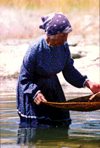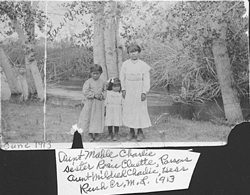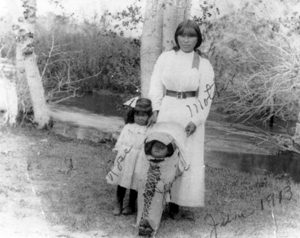 Mrs.
Jessie Durant
Mrs.
Jessie Durant
Interview conducted by Emilie Strauss on 10/13/91 at Mrs. Durant's home in Bishop. A tape recorder was not used. Photos courtesy of Mrs. Jessie Durant.
ES: Tell me about your life on Rush Creek.
JD: I was born in 1913 and grew up in the Rush Creek
area, where my grandfather, Young Charlie, had several
acres of land. Our grandparents raised my sister and me,
as our mother had to work away from home to support us.
She worked as a maid for non-Indian families.
The Rush Creek area was a paradise. Vegetation was lush and green. There was aspen trees under which an abundance of wild onions grew. There was also cottonwood, Jeffrey Pine, and red and yellow buckberry trees.
On my paternal granparent's property was a spring where people gathered watercress. During spring and summer there was many varieties of beautiful wild flowers such as desert peach blossoms (tza na ve), irises, and many other flowers that grew all over the hills and meadows. My grandfather also had the family burial ground nearby which is still used from time to time.
We had a wholesome and happy life. It was freedom.
There was no sound of cars, just the sound of rushing,
gurgling Rush Creek nearby. We would awaken in the early
dawn to the chirping and singing of the birds. Many
different kinds of birds made their nests in the bushes
and trees in the meadows. We observed their eggs from
time to time, never disturbing them. And soon they were
out of their nests and on their own. Cottontails and
jackrabbits made their homes under the sagebrush.
Sometimes the eerie sound of the horned owls was heard hooting during the night, this was very frightening to the Indian people. We elders are superstitious people. The hooting of the horned owl means unpleasant news, an illness or death.
As children, we roamed all over the hills and meadows near Rush Creek barefoot. The soles of our feet were calloused just like leather. Each one of us carried a digging stick (podo) and a small bucket, looking for edible plants, roots and bulbs, such as the Mariposa lily, known as ko-ge-ha. We also gathered many other greens, and made chewing gum out of rabbitbrush bark.
Rush Creek was quite swift in certain areas, but there were good pools for fishing, which were plentiful at the time. We used willows for poles, string for line and pins for hooks. Insects, worms and grasshoppers were used for bait. During the summer, the fish were roasted out of doors on charcoal.
All families made use of Mono Lake for swimming, bathing and doing the laundry. Mono Lake water was an excellent detergent. Our elders said Mono Lake water (ku-za-pa-a) was good panacean medicine.
Our grandparents showed us where, when and how to prepare various kinds of our culture foods and materials. We were taught to always give thanks to our creator of life after gathering or picking anything.
During the winter months, the air and weather is very cold, crisp and invigorating with the dense fog (pa-gu-na-bu) suspended heavily all around. To-go-au on his horse would return home after game hunting, looking like "Frosty the Snowman," his hair, eyebrows, and mustache covered with frost (who-sea-pu). His favorite hunting horse's mane and eyelashes were covered with frost.
I vividly remember one winter when our supply of staple food was low. It was a harsh winter with very deep snow and we experienced famine. Snow was boiled for domestic purposes. Even though this was a treacherous time, as children, we still played and had fun making tunnels through the snow.
We made pine nut soup, or gruel, by mixing the pulverized nuts with cold water to whatever consistency desired. This is eaten by using the index and middle fingers to scoop it out of the basket or bowl. I call it Paiute poi. The gruel is put into small bowls and placed on the top of the houses to freeze, making a delightful treat, Paiute Ice Cream.
That winter To-go-au (grandfather) was unable to go hunting for game. But most of the winters were not quite so severe and grandfather was able to hunt for deer and jackrabbits. There were times when he came home with a gunnysack full of rabbits or edible fowl, from which we made soup. Duck, or geese feathers made good down pillows and rabbit skins were made into fluffy blankets. Venison meat was made into jerky, and fish from Grant Lake was dried. During the late spring, the menfolks made rafts from willows to sail to the island in Mono Lake to gather seagull eggs, and these were another source of food the elders used.
At the confluence of Rush and Walker Creeks is a 'narrows' in which a waterfall flows down and forms a pond. We were told by the elders that this was the waterbabies' (pa-o-ha-a) habitat and at times could be heard crying. We would toss sticks into the pond and watched them swirl around and around. It was an intriguing and fascinating thing to watch.
Above the narrows are large communal bedrocks with severl mortars, where the women pounded and ground acorns, pine nuts, and various kinds of nutritious seeds. This site is called Te-ba-tze-ga.
ES: Did you ever swim in Rush Creek?
JD: We all swam in Rush Creek.
ES: Have you been back to Rush Creek recently?
JD: Yes. I visited last summer. In 1960, my sister Rosie and her family and I visited the area. It looked totally different. It was difficult to locate our homesites.
ES: What happened to the houses after your grandfather sold the property to the Nev-Cal Company in 1929? Was he sad to leave the meadows?
JD: The houses were torn down and the boards were used to build two homes for his two families on the plateau above Te-ba-tze-ga where we all lived. After the sale of his property, To-go-au and the families moved to the west side of the Mattly's ranch. Yes, I believe To-go-au was sad to leave a beautiful place.
ES: Who else lived on lower Rush Creek then?
JD: Several of our relatives.
ES: What livestock fed along Rush Creek?
JD: Grandfather owned about twelve or fifteen horses. Along with the families' horses, they fed on the meadows in the summer and during the winter were kept in a corral and fed hay. The men mowed hay and had hay stacks.
ES: Were there willow along Rush Creek?
JD: It is well known that the Mono Lake Paiutes used the willows which grew nearby and along Rush Creek as the natural source of material for basket making. Some of the woven baskets were the finest made. The women were creative and artistic. Many of the baskets were prize winners at the Yosemite Indian Field Days. My sister, Rosie, and I learned to weave baskets early in life. Our grandmother, Nellie, taught us.
ES: What did the meadows look like around your grandfather's house?
JD: They were dry. Our homesites were on the outskirts of the meadows.
ES: Were the meadows irrigated? Do you remember irrigation ditches?
JD: According to my Uncle Foster, the menfolks made ditches and irrigated the meadows.
ES: What kinds of animals and wildlife do you remember?
JD: I remember deer, eagles, rabbits, grouse, or sagehens, but I'm sure there were others such as antelopes and wild sheep.
ES: Do you remember much about lower Parker Creek?
JD: No, I don't.
ES: Here are some old pictures (interview photos #2 and #3). This is a picture of some pondlike areas in the Rush Creek bottomlands. Does this look familiar?
JD: My uncle stated that there were pond-like areas in the Rush Creek bottomlands.
ES: How about this picture (photo #5) of a foot bridge across Rush Creek?
JD: Uncle also said that they made foot bridges across Rush Creek.
ES: Did people have vegetable gardens on Rush Creek?
JD: Yes. Also on the plateau, To-go-au had a potato patch. As children we ate potatoes raw.
ES: How did you get water at your grandfather's place on the plateau?
JD: We used buckets. We walked down the hill to the creek. It was rather fun going down but very laborious coming back up.
End of interview. Additional interviews with Mrs. Durant can be found in the 1998 documentary film "Battle For Mono Lake." Additional Kutzadika'a names for places in the Mono Basin can be found here. February 14, 2015 obituary in the Inyo Register.
